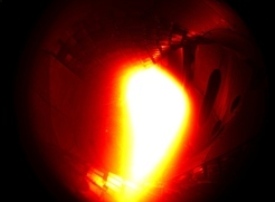Dec 12 2015
The plasma researchers’ efforts and patience have paid off. On December 10th, a good ten years after the assembly of the Wendelstein 7-X fusion device began at the Max Planck Institute for Plasma Physics (IPP) in Greifswald, physicists produced the first helium plasma. After over a year of technical preparation and tests, experimental operation has now commenced according to plan. With the Wendelstein 7-X, the world’s largest stellarator-type fusion device, the researchers would like to prove that this type of device is suitable for use as a power station.
 The first plasma in the Wendelstein 7-X fusion device in Greifswald presents itself with a bright glow. It consisted of helium and reached a temperature of about one million degrees Celsius. © IPP
The first plasma in the Wendelstein 7-X fusion device in Greifswald presents itself with a bright glow. It consisted of helium and reached a temperature of about one million degrees Celsius. © IPP
After a construction period of nine years and over one million assembly hours, the main construction work on the Wendelstein 7-X came to an end in April 2014. Preparation for the operation of the fusion device has been under way ever since. Scientists and technicians tested all of its components in turn; the vacuum in the vessels, the cooling system, the superconducting coils and the magnetic field they produce, the control system, and the heating devices and measuring instruments.
The time had finally come on December 10th: the operating team in the control room started up the magnetic field, in which the plasma is confined so that it does not come into contact with the wall of the plasma chamber and cools down. The experiment’s computer-operated control system was then activated. It fed around one milligram of helium gas into the plasma vessel, from which the air had already been evacuated. The team then switched on the microwave heating for a short 1.8-kilowatt pulse – and the first plasma could be observed by the installed cameras and measuring devices.
First hydrogen plasma to be produced by the end of January
“We’re starting with a plasma produced from the noble gas helium. We will not change over to the actual test object, a hydrogen plasma, until next year,” explains project leader Thomas Klinger, Director at Max Planck Institute for Plasma Physics (IPP) and head of the Wendelstein 7-X project. “This is because it’s easier to achieve the plasma state with helium. Moreover, we can clean the surface of the plasma vessel with helium plasmas,” he adds.
The first plasma in the machine lasted one tenth of a second and reached a temperature of around one million degrees. “We’re very satisfied,” says Hans-Stephan Bosch, whose division is responsible for the operation of the Wendelstein 7-X. “Everything went according to plan.”
In the next stages of the experiment, the researchers want to extend the duration of the plasma discharges and to investigate the best method for producing and heating helium plasmas using microwaves. After a break for New Year, confinement studies will resume in January when the scientist will test, among other things, how well the helium plasma is confined in the magnetic field. With these tests, the scientists will prepare the way for the first experiments with hydrogen plasma, which is ultimately intended to be fused into helium in the fusion experiments.